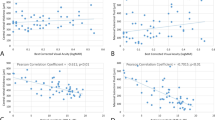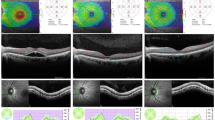Abstract
Purpose
The aim of this study was to compare dynamic thiol/disulfide homeostatic status in acute central serous chorioretinopathy (CSCR) patients by using a novel and automated assay determining dynamic thiol/disulfide homeostasis.
Methods
Fifty-one patients with acute CSCR (study group) and 65 healthy individuals (control group) were enrolled in this study. Diagnosis of acute CSCR was made clinically and using spectral-domain RTVue OCT (optical coherence tomography) (Optovue, Fremont, CA). Fluorescein angiography confirmed the diagnosis of acute CSCR in all subjects. Total thiol, native thiol, disulfide amount, and native thiol/disulfide ratio (TDR) were calculated in the blood samples.
Results
Mean total thiol, native thiol, and native TDR values were lower in patients with acute CSCR (364.2 ± 14.1, 326.4 ± 13.2, 17.14 ± 1.9, respectively) than in healthy eyes (441.2 ± 16.3, 398.5 ± 16.4, 22.70 ± 2.15, respectively; mean total thiol, p = 0.017; native thiol, p = 0.011; native TDR, p = 0.031).
Conclusions
Total thiol, native thiol, and native TDR were significantly lower statistically in patients with acute CSCR when compared with healthy controls.
Similar content being viewed by others
References
Tittl MK, Spaide RF, Wong D et al (1999) Systemic findings associated with central serous chorioretinopathy. Am J Ophthalmol 128:63–68
Haimovici R, Koh S, Gagnon DR et al (2004) Risk factors for central serous chorioretinopathy: a case-control study. Ophthalmology 111:244–249
Errera MH, Kohly RP, da Cruz L (2013) Pregnancy associated retinal diseases and their management. Surv Ophthalmol 58:127–142
Casella AM, Berbel RF, Bressanim GL et al (2012) Helicobacter pylori as a potential target for the treatment of central serous chorioretinopathy. Clinics (Sao Paulo) 67:1047–1052
Spahn C, Wiek J, Burger T et al (2003) Psychosomatic aspects in patients with central serous chorioretinopathy. Br J Ophthalmol 87:704–708
Fawzi AA, Holland GN, Kreiger AE et al (2006) Central serous chorioretinopathy after solid organ transplantation. Ophthalmology 113:805–813
Gass JD (1997) Specific diseases causing disciform macular detachment. Stereosc Atlas of Macul Dis 1:52–87
Wang M, Munch IC, Hasler PW et al (2008) Central serous chorioretinopathy. Acta Ophthalmol 86:126–145
Piccolino FC, Borgia L (1994) Central serous chorioretinopathy and indocyanine green angiography. Retina 14:231–242
Prunte C, Flammer J (1996) Choroidal capillary and venous congestion in central serous retinopathy. Am J Ophthalmol 121:126–134
Türkcü FM, Yüksel H, Yüksel H et al (2014) Serum dehydroepiandrosterone sulphate, total antioxidant capacity, and total oxidant status in central serous chorioretinopathy. Graefes Arch Clin Exp Ophthalmol 252(1):17–21
Field MG, Elner VM, Park S et al (2000) Detection of retinal metabolic stress resulting from central serous retinopathy. Retina 29(8):1162–1166
Guyer DR, Yannuzzi LA, Slakter JS et al (1994) Digital indocyanine green videoangiography of central serous chorioretinopathy. Arch Ophthalmol 112:1057–1062
Sen CK, Packer L et al (2000) Thiol homeostasis and supplements in physical exercise. Am J Clin Nutr 72:653–669
Turell L, Radi R, Alvarez B (2013) The thiol pool in human plasma: the central contribution of albumin to redox processes. Free Radic Biol Med 65:244–253
Cremers CM, Jakob U (2013) Oxidant sensing by reversible disulfide bond formation. J Biol Chem 288(37):26489–26496
Jones DP, Liang Y (2009) Measuring the poise of thiol/disulfide couples in vivo. Free Radic Biol Med 47(10):1329–1338
Biswas S, Chida AS, Rahman I (2006) Redox modifications of protein–thiols: emerging roles in cell signaling. Biochem Pharmacol 71(5):551–564
Circu ML, Aw TY (2010) Reactive oxygen species, cellular redox systems, and apoptosis. Free Radic Biol Med 48(6):749–762
Matteucci E, Giampietro O et al (2010) Thiol signalling network with an eye to diabetes. Molecules 15(12):8890–8903
Go YM, Jones DP (2011) Cysteine/cystine redox signaling in cardiovascular disease. Free Radic Biol Med 50(4):495–509
Prabhu A, Sarcar B, Kahali S et al (2014) Cysteine catabolism: a novel metabolic pathway contributing to glioblastoma growth. Cancer Res 74(3):787–796
Tetik S, Ahmad S, Alturfan AA et al (2010) Determination of oxidant stress in plasma of rheumatoid arthritis and primary osteoarthritis patients. Indian J Biochem Biophys 47(6):353–358
Rodrigues SD, Batista GB, Ingberman M et al (2012) Plasma cysteine/cystine reduction potential correlates with plasma creatinine levels in chronic kidney disease. Blood Purif 34(3–4):231–237
Sbrana E, Paladini A, Bramanti E et al (2004) Quantitation of reduced glutathione and cysteine in human immunodeficiency virus-infected patients. Electrophoresis 25(10–11):1522–1529
Calabrese V, Lodi R, Tonon C et al (2005) Oxidative stress, mitochondrial dysfunction and cellular stress response in Friedreich’s ataxia. J Neurol Sci 33(1–2):145–162
Smeyne M, Smeyne RJ (2013) Glutathione metabolism and Parkinson’s disease. Free Radic Biol Med 62:13–25
Steele ML, Fuller S, Maczurek AE et al (2013) Chronic inflammation alters production and release of glutathione and related thiols in human U373 astroglial cells. Cell Mol Neurobiol 33(1):19–30
Kuo LM, Kuo CY, Lin CY et al (2014) Intracellular glutathione depletion by oridonin leads to apoptosis in hepatic stellate cells. Molecules 19(3):3327–3344
Erel O, Neselioglu S (2014) A novel and automated assay for thiol/disulphide homeostasis. Clin Biochem 47:326–332
Klais CM, Ober MD, Ciardella AP et al (2006) Central serous chorioretinopathy. In: Ryan SJ (ed) Retina, vol II, 4th edn. Mosby, St Louis, pp 1135–1161
Piccolino FC, Eandi CM, Ventre L et al (2003) Photodynamic therapy for chronic central serous chorioretinopathy. Retina 23:752–763
Taban M, Boyer DS, Thomas EL et al (2004) Chronic central serous chorioretinopathy: photodynamic therapy. Am J Ophthalmol 137:1073–1080
Guyer DR, Yannuzzi LA, Slakter JS et al (1994) Digital indocyanine green videoangiography of central serous chorioretinopathy. Arch Ophthalmol 112:1057–1062
Yavas GF, Kusbeci T, Kasikci M et al (2014) Obstructive sleep apnea in patients with central serous chorioretinopathy. Curr Eye Res 39(1):88–92
Ratanasukon M, Bhurayanontachai P, Jirarattanasopa P (2012) High-dose antioxidants for central serous chorioretinopathy; the randomized placebo-controlled study. BMC Ophthalmol 12:20
Dean RT, Fu S, Stocker R et al (1997) Biochemistry and pathology of radical-mediated protein oxidation. Biochem J 324:1–18
Kundi H, Erel O, Balun A et al (2015) Association of thiol/disulfide ratio with syntax score in patients with NSTEMI. Scand Cardiovasc J 49:95–100
Kundi H, Ates I, Kiziltunc E et al (2015) A novel oxidative stress marker in acute myocardial infarction; thiol/disulphide homeostasis. Am J Emerg Med 33(11):1567–1571
Altiparmak IH, Erkus ME, Sezen H et al (2016) Evaluation of thiol levels, thiol/disulfide homeostasis and their relation with inflammation in cardiac syndrome X. Coron Artery Dis 27(4):295–301
Turkoglu EB, Dikci S, Çelik E et al (2016) Thiol/disulfide homeostasis in patients with central serous chorioretinopathy. Curr Eye Res 22:1–3
Ziegler D (1985) Role of reversible oxidation-reduction of enzyme thiols-disulfides in metabolic regulation. Annu Rev Biochem 54:305–329
Mccord JM (1993) Human disease, free radicals, and the oxidant/antioxidant balance. Clin Biochem 26:351–357
Jiang S, Moriarty-Craige SE, Orr M et al (2005) Oxidant induced apoptosis in human retinal pigment epithelial cells: dependence on extracellular redox state. Invest Ophthalmol Vis Sci 46:1054–1061
Dean O, Giorlando F, Berk M (2011) N-Acetylcysteine in psychiatry: current therapeutic evidence and potential mechanisms of action. J Psychiatry Neurosci 36:78–86
Hardy P, Abram D, Li DY et al (1994) Free radicals in retinal and choroidal blood flow autoregulation in the piglet: interaction with prostaglandins. Invest Ophthalmol Vis Sci 35:580–591
Szabo C, Thiemermann C, Vane JR (1993) Inhibition of the production of nitric oxide and vasodilator prostaglandins attenuates the cardiovascular response to bacterial endotoxin in adrenalectomized rats. Proc R Soc Lond B Biol Sci 11:233–238
Beatty S, Koh H, Phil M et al (2000) The role of oxidative stress in the pathogenesis of age-related macular degeneration. Surv Ophthalmol 45:115–134
Ames BN, Shigenaga MK, Hagen TM et al (1993) Oxidants, antioxidants, and the degenerative diseases of aging. Proc Natl Acad Sci 90:7915–7922
Erel O (2004) A novel automated method to measure total antioxidant response against potent free radical reactions. Clin Biochem 37:112–119
Erel O (2005) A new automated colorimetric method for measuring total oxidant status. Clin Biochem 38:1103–1111
Author information
Authors and Affiliations
Corresponding author
Ethics declarations
Conflict of interest
The authors declare no financial or proprietary interests.
Ethical approval
The study protocol followed the principles in the Declaration of Helsinki.
Informed consent
Informed consent was obtained from all individual participants included in the study.
Rights and permissions
About this article
Cite this article
Altinkaynak, H., Kurkcuoglu, P.Z., Caglayan, M. et al. A novel marker in acute central serous chorioretinopathy: thiol/disulfide homeostasis. Int Ophthalmol 38, 175–181 (2018). https://doi.org/10.1007/s10792-017-0444-3
Received:
Accepted:
Published:
Issue Date:
DOI: https://doi.org/10.1007/s10792-017-0444-3




